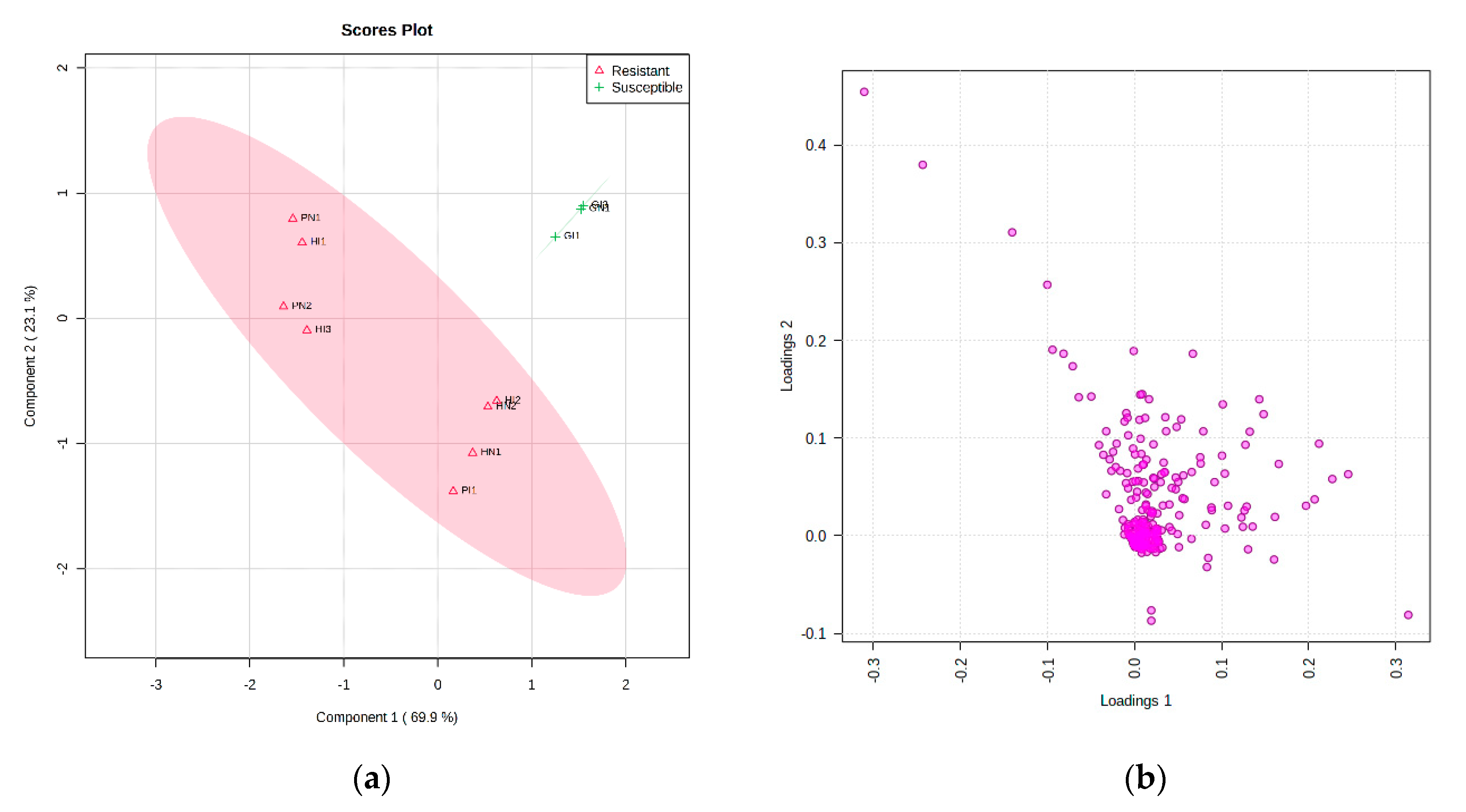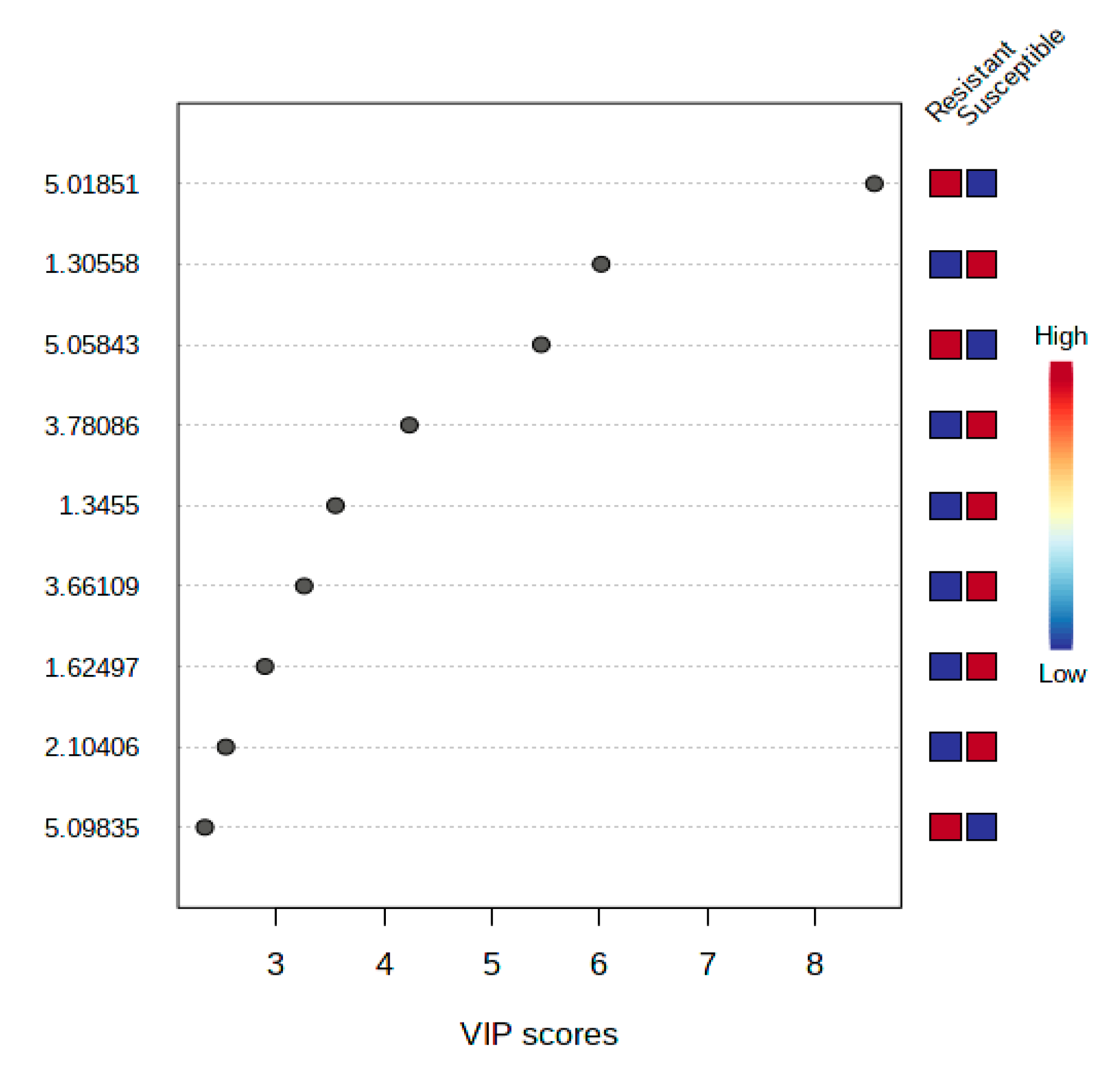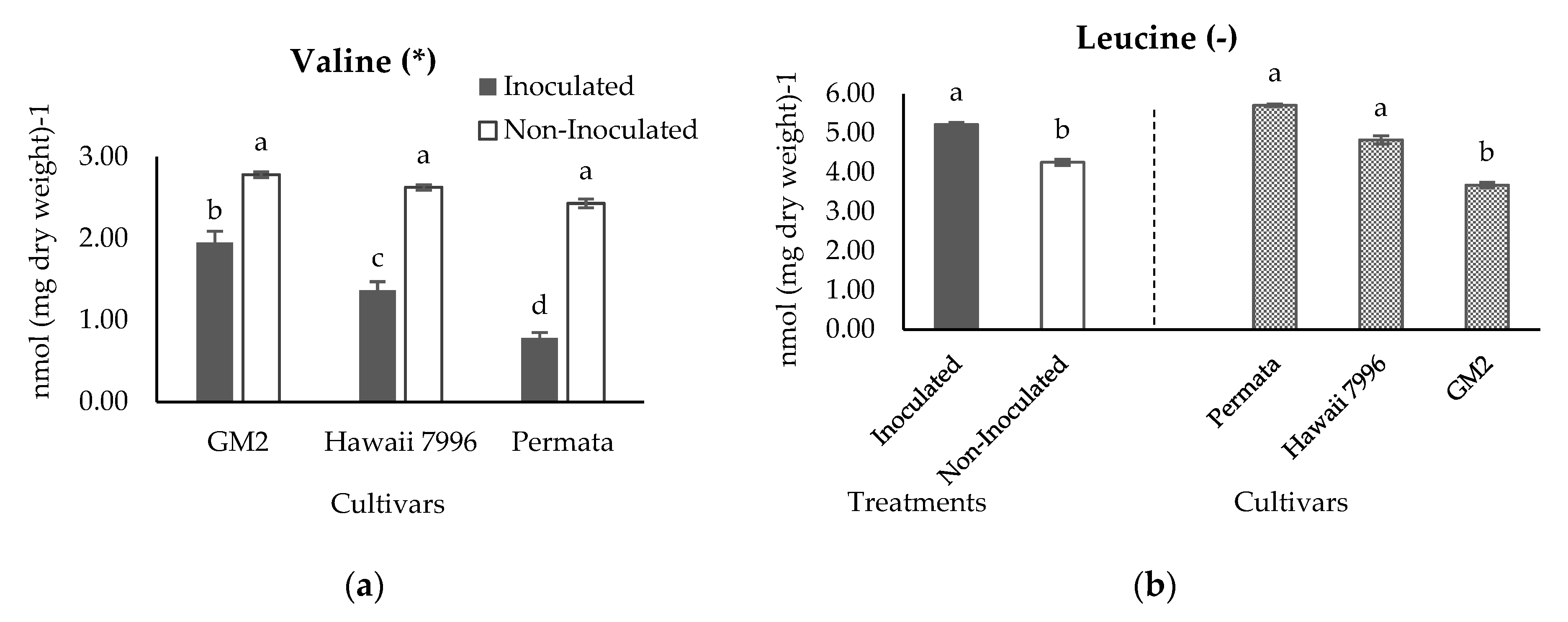Metabolomic Response of Tomatoes (Solanum lycopersicum L.) against Bacterial Wilt (Ralstonia solanacearum) Using 1H-NMR Spectroscopy
Abstract
:1. Introduction
2. Results
2.1. Disease Symptoms in Plants of Three Cultivars
2.2. Plant Metabolomics
3. Discussion
4. Materials and Methods
4.1. Bacterial Inoculum
4.2. Plant Materials
4.3. Experimental Procedure
4.4. Statistical Analysis
4.5. 1H-NMR Measurement
4.6. Data Quantification
5. Conclusions
Author Contributions
Funding
Institutional Review Board Statement
Informed Consent Statement
Data Availability Statement
Acknowledgments
Conflicts of Interest
References
- Baichoo, Z.; Jaufeerally-Fakim, Y. Ralstonia solanacearum upregulates marker genes of the salicylic acid and ethylene signaling pathways but not those of the jasmonic acid pathway in leaflets of Solanum lines during early stage of infection. Eur. J. Plant Pathol. 2017, 147, 615–625. [Google Scholar] [CrossRef]
- Peeters, N.; Guidot, A.; Vailleau, F.; Valls, M. Ralstonia solanacearum, a widespread bacterial plant pathogen in the post-genomic era. Mol. Plant Pathol. 2013, 14, 651–662. [Google Scholar] [CrossRef] [Green Version]
- Raza, W.; Ling, N.; Yang, L.; Huang, Q.; Shen, Q. Response of tomato wilt pathogen Ralstonia solanacearum to the volatile organic compounds produced by a biocontrol strain Bacillus amyloliquefaciens SQR-9. Sci. Rep. 2016, 6, 24856. [Google Scholar] [CrossRef] [PubMed] [Green Version]
- Singh, S.; Singh, D.R.; Kumar, K.; Birah, A. Eco-friendly management modules for bacterial wilt (Ralstonia solanacearum) of tomato for protected cultivation in a tropical Island ecosystem. Biol. Agric. Hortic. 2014, 30, 219–227. [Google Scholar] [CrossRef]
- Hong, Y.; Liu, S.P.; Zhu, Y.P.; Xie, C.; Jue, D.W.; Chen, M.; Kaleri, H.A.; Yang, Q. Expression of the MSI-99 m gene in transgenic potato plants confers resistance to Phytophthora infestans and Ralstonia solanacearum. Plant Mol. Biol. Rep. 2013, 31, 418–424. [Google Scholar] [CrossRef]
- Aslam, M.N.; Mukhtar, T.; Hussain, M.A.; Raheel, M. Assessment of resistance to bacterial wilt incited by Ralstonia solanacearum in tomato germplasm. J. Plant Dis. Prot. 2017, 124, 585–590. [Google Scholar] [CrossRef]
- Zeiss, D.R.; Mhlongo, M.I.; Tugizimana, F.; Steenkamp, P.A.; Dubery, I.A. Metabolomic profiling of the host response of tomato (Solanum lycopersicum) following infection by Ralstonia solanacearum. Int. J. Mol. Sci. 2019, 20, 3945. [Google Scholar] [CrossRef] [Green Version]
- Lowe-Power, T.M.; Hendrich, C.G.; Roepenack-Lahaye, E.V.; Li, B.; Wu, D.; Mitra, R.; Dalsing, B.L.; Ricca, P.; Naidoo, J.; Cook, D.; et al. Metabolomics of tomato xylem sap during bacterial wilt reveals Ralstonia solanacearum produces abundant putrescine, a metabolite that accelerates wilt disease. Environ. Microbiol. 2018, 20, 1330–1349. [Google Scholar] [CrossRef]
- Courant, F.; Antignac, J.P.; Dervilly-Pinel, G.; Le Bizec, B. Basics of mass spectrometry-based metabolomics. Proteomics 2014, 14, 2369–2388. [Google Scholar] [CrossRef]
- Afifah, E.N.; Murti, R.H.; Nuringtyas, T.R. Metabolomics approach for the analysis of resistance of four tomato genotypes (Solanum lycopersicum L.) to root-knot nematodes (Meloidogyne incognita). Open Life Sci. 2019, 14, 141–149. [Google Scholar] [CrossRef]
- Bisht, H.; Bhagat, D.; Bhatnagar, M.K. Metabolic profiling of tomatoes with pest infestation using GC-MS and NMR spectroscopy. IJPPR 2014, 6, 550–556. [Google Scholar]
- Leiss, K.A.; Choi, Y.H.; Verpoorte, R.; Klinkhamer, P.G. An overview of NMR-based metabolomics to identify secondary plant compounds involved in host plant resistance. Phytochem. Rev. 2011, 10, 205–216. [Google Scholar] [CrossRef] [PubMed] [Green Version]
- Garcia, G.P.; Neves dos Santos, F.; Zanotta, S.; Eberlin, M.N.; Carazzone, C. Metabolomics of Solanum lycopersicum infected with Phytophthora infestans leads to early detection of Late Blight in asymptomatic plants. Molecules 2018, 23, 3330. [Google Scholar] [CrossRef] [Green Version]
- Bevilacqua, M.; Bro, R. Can we trust score plots? Metabolites 2020, 10, 278. [Google Scholar] [CrossRef]
- Truong, T.H.H.; Esch, E.; Wang, J.F. Screening of wild tomato germplasm for resistance to race 1 strain of Ralstonia solanacearum. In Proceedings of the Second International Symposium on Tomato Diseases, Kusadasi, Turkey, 8–12 October 2007. [Google Scholar]
- Doughari, J.H. An overview of plant immunity. J. Plant Pathol. Microbiol. 2015, 6, 11. [Google Scholar]
- Karre, S.; Kumar, A.; Dhokane, D.; Kushalappa, A.C. Metabolo-transcriptome profiling of barley reveals induction of chitin elicitor receptor kinase gene (HvCERK1) conferring resistance against Fusarium graminearum. Plant Mol. Biol. 2017, 93, 247–267. [Google Scholar] [CrossRef] [PubMed]
- Isah, T. Stress and defense responses in plant secondary metabolites production. Biol. Res. 2019, 52, 39. [Google Scholar] [CrossRef] [Green Version]
- Ji, E.; Parthasarathy, A.; Corbitt, T.S.; Schanze, K.S.; Whitten, D.G. Antibacterial activity of conjugated polyelectrolytes with variable chain lengths. Langmuir 2011, 27, 10763–10769. [Google Scholar] [CrossRef]
- Mukherjee, I.; Ghosh, A.; Bhadury, P.; Priyadarsi-De, Y. Side-chain amino acid-based cationic antibacterial polymers: Investigating the morphological switching of a polymer-treated bacterial cell. ACS Omega 2017, 2, 1633–1644. [Google Scholar] [CrossRef]
- Padmanabhan, M.; Cournoyer, P.; Dinesh-Kumar, S.P. The leucine-rich repeat domain in plant innate immunity: A wealth of possibilities. Cell Microbiol. 2009, 11, 191–198. [Google Scholar] [CrossRef] [PubMed] [Green Version]
- Yuan, N.; Yuan, S.; Li, Z.; Zhou, M.; Wu, P.; Hu, Q.; Mendu, V.; Wang, L.; Luo, H. Stress induced factor 2, a Leucine-Rich Repeat Kinase regulates basal plant pathogen defense. Plant Physiol. 2018, 176, 3062–3080. [Google Scholar] [CrossRef] [Green Version]
- Chakraborty, S.; Nguyen, B.; Wasti, S.D.; Xu, G. Plant Leucine-Rich Repeat Receptor Kinase (LRR-RK): Structure, ligand perception, and activation mechanism. Molecules 2019, 24, 3081. [Google Scholar] [CrossRef] [Green Version]
- Zeier, J. New insights into the regulation of plant immunity by amino acid metabolic pathways. Plant Cell Environ. 2013, 36, 2085–2103. [Google Scholar] [CrossRef] [PubMed]
- Fan, J.; Crooks, C.; Creissen, G.; Hill, L.; Fairhurst, S.; Doerner, P.; Lamb, C. Pseudomonas sax genes overcome aliphatic isothiocyanate-mediated non-host resistance in Arabidopsis. Science 2011, 331, 1185–1188. [Google Scholar] [CrossRef] [PubMed]
- Návarová, H.; Bernsdorff, F.; Döring, A.-C.; Zeier, J. Pipecolic acid, an endogenous mediator of defense amplification and priming, is a critical regulator of inducible plant immunity. Plant Cell 2012, 24, 5123–5141. [Google Scholar] [CrossRef] [PubMed] [Green Version]
- Yang, J.; Duan, G.; Li, C.; Liu, L.; Han, G.; Zhang, Y.; Wang, C. The cross-talks between jasmonic acid and other plant hormone signaling highlight the involvement of jasmonic acid as a core component in plant response to biotic and abiotic stresses. Front. Plant Sci. 2019, 10, 1349. [Google Scholar] [CrossRef] [Green Version]
- Mikkelsen, M.D.; Halkier, B.A. Metabolic engineering of valine- and isoleucine-derived glucosinolates in Arabidopsis expressing CYP79D2 from cassava. Plant Physiol. 2003, 131, 773–779. [Google Scholar] [CrossRef] [PubMed] [Green Version]
- Azevedo, R.A.; Lancien, M.; Lea, P.J. The aspartic acid metabolic pathway, an exciting and essential pathway in plants. Amino Acids 2006, 30, 143–162. [Google Scholar] [CrossRef]
- Al Sinani, S.; Eltayeb, E. The steroidal glycoalkaloids solamargine and solasonine in Solanum plants. S. Afr. J. Bot. 2017, 112, 253–269. [Google Scholar] [CrossRef]
- Kim, S.G.; Hur, O.S.; Ro, N.Y.; Ko, H.C.; Rhee, J.H.; Sung, J.S.; Ryu, K.Y.; Lee, S.Y.; Baek, H.J. Evaluation of resistance to Ralstonia solanacearum in tomato genetic resources at seedling stage. Plant Pathol. J. 2016, 32, 58–64. [Google Scholar] [CrossRef] [Green Version]
- Maulida, I.; Murti, R.H.; Arwiyanto, T. Selection and inheritance of tomato resistance against Ralstonia solanacearum. JPTI 2019, 23, 61–67. [Google Scholar] [CrossRef]
- East West Seed Indonesia. Available online: https://www.panahmerah.id/product/permata-f1 (accessed on 11 May 2021).
- Fan, X.-Y.; Lin, W.-P.; Liu, R.; Jiang, N.-H.; Cai, K.Z. Physiological response and phenolic metabolism in tomato (Solanum lycopersicum) mediated by silicon under Ralstonia solanacearum infection. JIA 2018, 17, 2160–2171. [Google Scholar] [CrossRef] [Green Version]
- Chen, K.; Khan, R.A.A.; Cao, W.; Ling, M. Sustainable and ecofriendly approach of managing soil born bacterium Ralstonia solanacearum (Smith) using dried powder of Conyza canadensis. Pathogens 2020, 9, 327. [Google Scholar] [CrossRef]
- Schripsema, J.; Dagnino, D. Two-phase extraction for comprehensive analysis of the plant metabolome by NMR. Methods Mol. Biol. 2018, 1738, 195–202. [Google Scholar]
- López-Gresa, M.P.; Federica, M.; Jose, M.B. Metabolic response of tomato leaves upon different plant–pathogen interactions. Phytochem. Anal. 2010, 21, 89–94. [Google Scholar] [CrossRef] [PubMed]
- Kim, H.K.; Verporte, R. Sample preparation for plant metabolomics. Phytochem. Anal. 2010, 21, 4–13. [Google Scholar] [CrossRef]
- Escudero, N.; Marhuenda-Egea, F.C.; Ibanco-Can, R.; Zavala-Gonzalez, E.A.; Lopez-Llorca, L.V. A metabolomic approach to study the rhizodeposition in the tritrophic interaction: Tomato, Pochoniachlamydosporia and Meloidogyne javanica. Metabolomics 2014, 10, 788–804. [Google Scholar] [CrossRef] [Green Version]







| Metabolite | Chemical Shift (ppm) and Coupling Constants (Hz) |
|---|---|
| Leucine | 0.94 (d, J = 0.7 Hz) |
| Valine | 1.00 (d, J = 7.0 Hz); 1.05 (d, J = 7.0 Hz) |
| Alanine | 1.44 (d, J = 7.2 Hz) |
| Acetic acid | 1.94 (s) |
| Succinate | 2.53 (s) |
| GABA (γ-amino-butyric acid) | 1.88 (m); 2.37 (t, J = 7.2 Hz); 2.95 (t, J = 7.08 Hz) |
| Ethanolamine | 3.12 (t, J = 5.5 Hz) |
| Choline | 3.19 (s) |
| Glycine | 3.5 (s) |
| β-glucose | 4.45 (d, J = 7.8 Hz) |
| α-glucose | 5.09 (d, J = 3.76 Hz) |
Publisher’s Note: MDPI stays neutral with regard to jurisdictional claims in published maps and institutional affiliations. |
© 2021 by the authors. Licensee MDPI, Basel, Switzerland. This article is an open access article distributed under the terms and conditions of the Creative Commons Attribution (CC BY) license (https://creativecommons.org/licenses/by/4.0/).
Share and Cite
Murti, R.H.; Afifah, E.N.; Nuringtyas, T.R. Metabolomic Response of Tomatoes (Solanum lycopersicum L.) against Bacterial Wilt (Ralstonia solanacearum) Using 1H-NMR Spectroscopy. Plants 2021, 10, 1143. https://doi.org/10.3390/plants10061143
Murti RH, Afifah EN, Nuringtyas TR. Metabolomic Response of Tomatoes (Solanum lycopersicum L.) against Bacterial Wilt (Ralstonia solanacearum) Using 1H-NMR Spectroscopy. Plants. 2021; 10(6):1143. https://doi.org/10.3390/plants10061143
Chicago/Turabian StyleMurti, Rudi Hari, Enik Nurlaili Afifah, and Tri Rini Nuringtyas. 2021. "Metabolomic Response of Tomatoes (Solanum lycopersicum L.) against Bacterial Wilt (Ralstonia solanacearum) Using 1H-NMR Spectroscopy" Plants 10, no. 6: 1143. https://doi.org/10.3390/plants10061143






